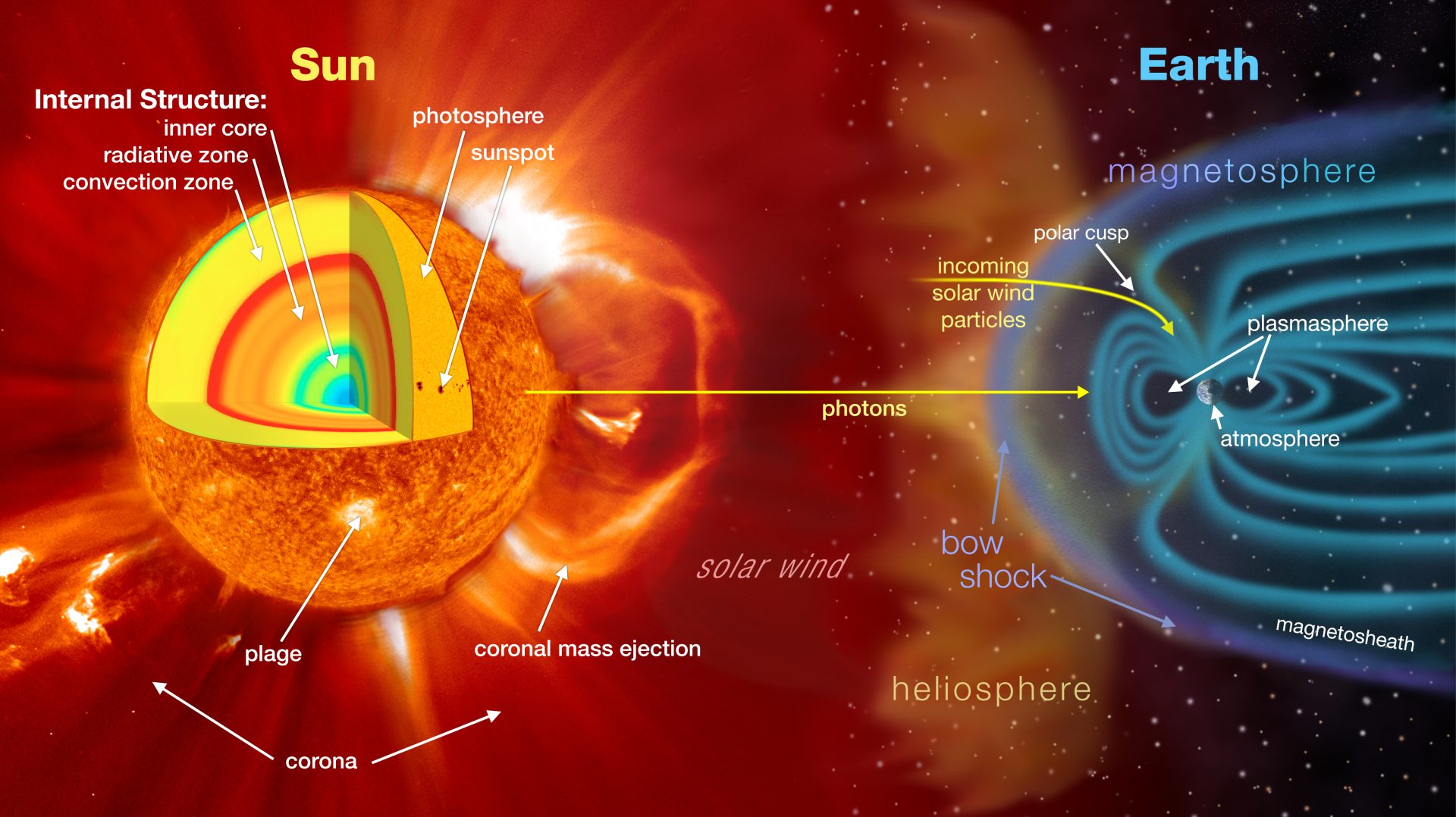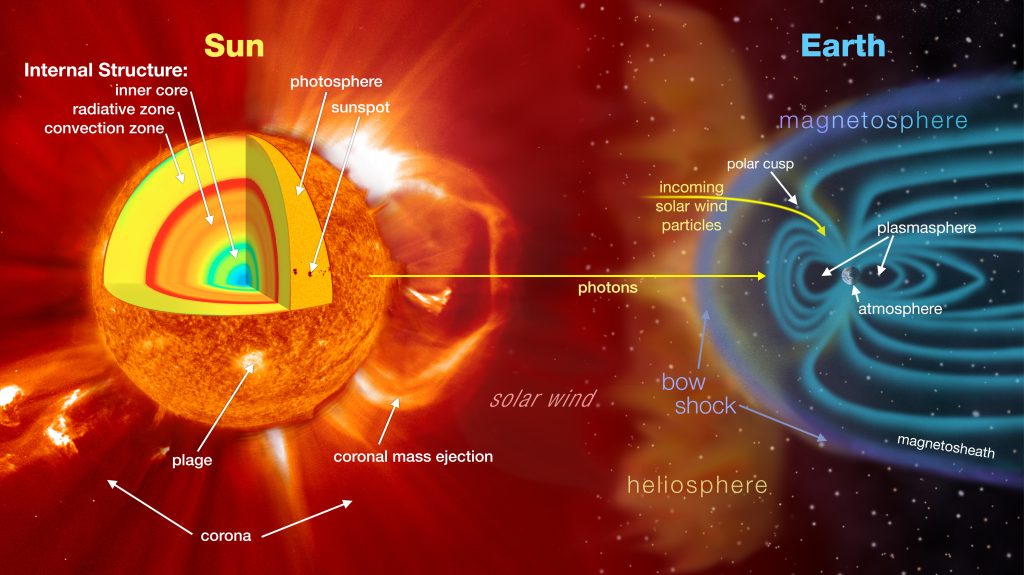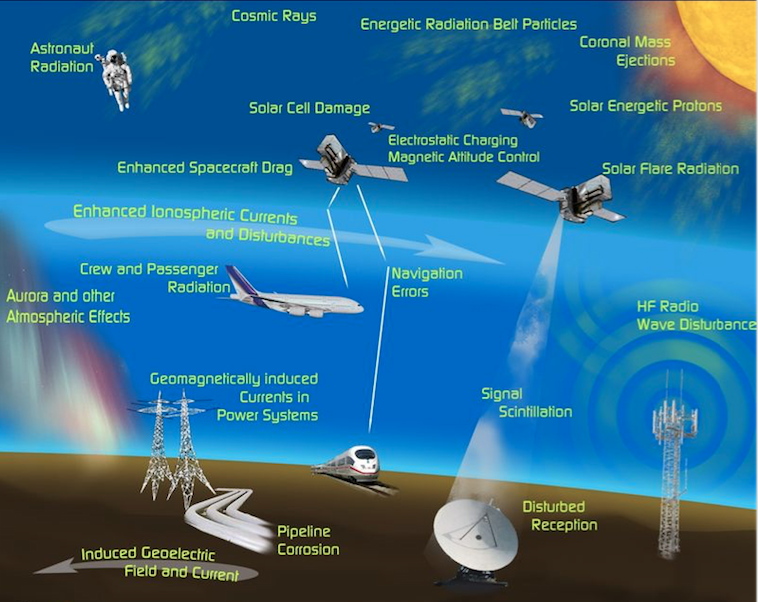
Space weather
Written by: Edin Husidic, Lidiya Annie John, Mayank Kumar, Andreas Wagner, Augustin André-Hoffmann, Shreeyesh Biswal, Jayesh Goswami, Shifana Koya, Anwesha Maharana, Mariia Pelekhata, Juska Räsänen, Noemi Zsamberger, Tinatin Baratashvili, Robert Niedziela, Seve Nyberg, Sotiris Stamkos
Just as the Earth has a weather, outer space also has a weather, called ‘space weather’. Space weather is the influence of the Sun on our solar system (especially on our planet Earth) due to changes of Sun’s magnetic activity and its related phenomena, including solar wind, solar eruptions, and Solar Energetic Particles (SEPs). The Sun has an 11-year long activity cycle during which its activity increases and decreases, and so does the number and intensity of space weather storms at Earth. At times of high solar activity, the Sun can produce an incredible amount of big eruptions, even several times per day.
Sun – Earth interactions
As the solar wind consists of charged particles, it can interact with Earth’s magnetic field as they meet. The solar wind causes a pressure on Earth’s magnetic field and it modifies it into an extended teardrop shape called the magnetosphere. The boundary of the Earth’s magnetosphere is called the magnetopause. The terrestrial magnetosphere forms a protective bubble around us that protects us from radiation from the Sun and from cosmic rays and around which the solar wind flows.
Magnetic energy stored on the surface of the Sun can erupt violently in coronal mass ejections (CMEs) where plasma and magnetic field is spawn out of the solar surface into the solar wind. During this process solar material of up to 1012 kilograms (about the mass of 1 million Eifel towers!) can be hurled out into interplanetary space at extortionate speeds. These erupting plasma clouds usually travel faster than the solar wind, disrupting the normal flow and often also form shock waves in the solar wind. They reach the Earth orbit typically in a few days and interact with the Earth’s magnetosphere causing aurorae and other space weather effects through complex chain of events inside the Earth’s magnetosphere.
The high energy particles in SEP events accelerated by solar eruption can reach Giga electron-volt energies and they travel to Earth nearly at the speed of light reaching us thus as fast as in ten minutes. They are guided by the interplanetary magnetic field and can penetrate into the magnetosphere.

Space weather effects
The manifestations of solar activity can directly or indirectly be hazardous to our technological systems and life. Space weather storms may be impact to radio communication, satellite avionics, GPS navigation, and electrical power grids on the Earth, and may even pose as a health hazard to astronauts in space and to passengers and crew on high-altitude airplane flights. Our interest in space weather research is not only limited to effects at Earth’s surface and orbit, but also reaches beyond. A potential damage is also worrying for planned human missions to Mars, where astronauts would be exposed to solar radiation for extended periods of time, as Mars, unlike Earth, has no global magnetic field to shield the radiation.
The most energetic protons can even penetrate the Earth’s magnetic field and atmosphere and hit the ground, creating rare events known as Ground Level Enhancements detected by ground-based neutron monitors. As they pass through the atmosphere and collide with its atoms and molecules, they generate a shower of high-energy secondary particles. These, in turn, can contribute to the danger of an increased radiation dose for passengers and crews on planes flying at high altitudes.

Extreme space weather events can have serious impacts on our technology, health, and financial sectors. The strongest space weather events are almost exclusively caused by CMEs. Read more about extreme space weather events that happened at Earth in the past here.
Ensemble observations, both in-situ and via remote sensing, as well as more information about the full solar surface are necessary for a precise prediction of space weather events. Hence, developments of spacecraft and ground-based solar observatories that monitor the Sun, coupled with numerical simulations that are a critical element in space weather forecasts, are paramount for our understanding of the physics behind space weather events and improving space weather predictions.
